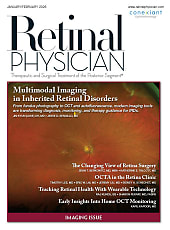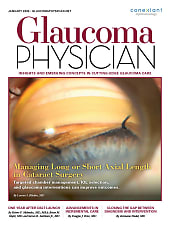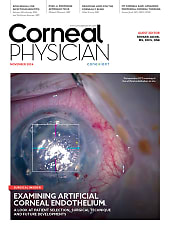Angle-closure glaucoma is a rare, vision-threatening condition that can develop after pupil dilation. Many of us may not have seen a dilation-related case even after years in ophthalmology and retina training, but this complication can also go unrecognized.
At our institution, we identified an asymptomatic patient with angle narrowing and bilateral intraocular pressure (IOP) elevation to 35 mm Hg after dilation. Dilated exam of each eye revealed a nuclear sclerotic cataract and a disc-cup ratio of 0.6. Ultrasound biomicroscopy (UBM) revealed an occluded angle that deepened after laser peripheral iridotomy (Figure 1).

We realized that we did not check for risk of angle closure due to pupil dilation before the patient was seen in the retina clinic. In response, we devised an evidence-based protocol to prescreen patients prior to dilation. The criteria are simple and can be obtained by ophthalmic technicians, so that the physician only has to evaluate patients at risk for angle closure.
PROTOCOL
Patients at high risk of angle-closure glaucoma require inspection by an ophthalmologist, optometrist, resident, fellow, or other qualified clinical trainee prior to pharmacologic dilation. The adjacent decision tree (Table 1) includes screening criteria that will help an ophthalmic technician or nurse assess the risk and determine whether it is safe to dilate prior to anterior segment inspection.

New phakic patients with a hyperopic refraction of +1.00 D or greater must be examined for anterior chamber depth prior to administering dilation drops. Acceptable methods of determining refraction include outside optometry or ophthalmology note, autorefraction, lensometry, or refraction. If the patient is determined to have shallow angles on an undilated exam, their chart must be annotated to indicate that the patient requires laser peripheral iridotomy (LPI) prior to dilation. Once the LPI(s) have been completed, the chart must be updated. The patient can then be considered low risk for dilation.
Due to the rare nature of this complication, patients may be assessed at their initial visit only. Furthermore, patients who have already had cataract surgery are low risk and should be emmetropic, so this screening test would be irrelevant. Therefore, pseudophakic patients do not routinely need to be checked for chamber depth prior to dilation.
RATIONALE FOR PROTOCOL
Angle closure following dilation is rare but may go unrecognized. Lagan et al reviewed the rate of angle closure after pharmacologic dilation in a diabetic retinopathy screening program. In 4 years and 95,265 encounters, 3 cases were identified, for a rate of 1 in 35,755 encounters, or 0.75 cases per year.1 Wolfs et al reported an incidence of angle-closure glaucoma of 3 in 10,000 after pharmacologic dilation.2 Patel et al reported no episodes of angle closure after pharmacologic dilation of 4,870 patients.3 Thus we did not find it necessary to examine every patient prior to dilation.
Several associations with angle closure have been previously identified in the literature. Shen et al retrospectively examined the association between refractive error and glaucoma within the electronic health record from Kaiser Permanente of Northern California. Out of a database of 3.5 million active members, 2,339 were diagnosed with primary angle-closure glaucoma (PACG) and met criteria for the study. In that study, there was an increased odds ratio for PACG in patients with refractive error greater than +1.00 D spherical equivalent.4
Several studies have reported an association between shallow anterior chamber depth and PACG.5,6 Cataract surgery and clear lens extraction remove the mass of the crystalline lens and deepen the anterior chamber. In the EAGLE trial, clear lens extraction was shown to be superior to peripheral iridotomy at treating angle-closure glaucoma, causing lower intraocular pressure with fewer drops.7
Though the incidence of angle closure after pharmacologic dilation is rare, this complication is especially relevant in a retina clinic, where patients are routinely dilated by an ophthalmic technician or nurse prior to being seen by a doctor. Intraocular pressure is almost never checked after dilation and a retina specialist may not have access to a YAG laser to perform an emergency laser iridotomy. To avoid this issue, we present a simple screening algorithm to identify patients who may be at risk of developing angle closure.
CONCLUSION
Implementation of this protocol, which defines criteria for anterior segment inspection prior to dilation, minimizes the risk of angle-closure glaucoma after pharmacologic dilation. The criteria are clear and can quickly be assessed by clinic staff. NRP
REFERENCES
- Lagan MA, O’Gallagher MK, Johnston SE, Hart PM. Angle closure glaucoma in the Northern Ireland diabetic retinopathy screening programme. Eye (Lond). 2016;30(8):1091-1093. doi:10.1038/eye.2016.98
- Wolfs RC, Grobbee DE, Hofman A, de Jong PT. Risk of acute angle-closure glaucoma after diagnostic mydriasis in nonselected subjects: the Rotterdam study. Invest Ophthalmol Vis Sci. 1997;38(12):2683-2687.
- Patel KH, Javitt JC, Tielsch JM, et al. Incidence of acute angle-closure glaucoma after pharmacologic mydriasis. Am J Ophthalmol. 1995;120(6):709-717. doi:10.1016/s0002-9394(14)72724-2
- Shen L, Melles RB, Metlapally R, et al. The association of refractive error with glaucoma in a multiethnic population. Ophthalmology. 2016;123(1):92-101. doi:10.1016/j.ophtha.2015.07.002
- Lowe RF. Aetiology of the anatomical basis for primary angle-closure glaucoma. biometrical comparisons between normal eyes and eyes with primary angle-closure glaucoma. Br J Ophthalmol. 1970;54(3):161-169. doi:10.1136/bjo.54.3.161
- Xu L, Cao WF, Wang YX, Chen CX, Jonas JB. Anterior chamber depth and chamber angle and their associations with ocular and general parameters: the Beijing Eye Study. Am J Ophthalmol. 2008;145(5):929-936. doi:10.1016/j.ajo.2008.01.004
- Azuara-Blanco A, Burr J, Ramsay C, et al; EAGLE study group. Effectiveness of early lens extraction for the treatment of primary angle-closure glaucoma (EAGLE): a randomised controlled trial. Lancet. 2016;388(10052):1389-1397. doi:10.1016/S0140-6736(16)30956-4










